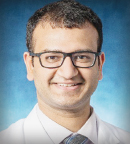Blowing air from a fan into the face of patients with advanced cancer experiencing breathlessness—and other nonpharmacologic interventions—may offer symptomatic relief, according to new research directed by Johns Hopkins Kimmel Cancer Center investigators and published in JAMA Oncology.1 In contrast, the investigators also found that medications such as opioids had limited impact in improving breathlessness.
In a systematic review of 29 randomized clinical trials of breathlessness in 2,423 adults with advanced cancer, researchers found several nonpharmacologic interventions were associated with improved breathlessness, including fan therapy and bilevel ventilation (air pressure delivered through a face mask covering the mouth and nose).
A companion report2 was published by the Agency for Healthcare Research and Quality (AHRQ), which sponsored this study along with ASCO and the Patient-Centered Outcomes Research Institute. These findings are informing an upcoming ASCO Clinical Practice Guideline on managing breathlessness in patients with advanced cancer.

Arjun Gupta, MD
“Breathlessness, or dyspnea, is a common and distressing symptom in patients with advanced cancer,” said lead author of the JAMA Oncology article, Arjun Gupta, MD, Chief Medical Oncology Fellow at the Johns Hopkins Kimmel Cancer Center. “Breathlessness can be associated with and made worse by accompanying anxiety and can severely impact quality of life and exercise capacity. In patients with advanced cancer, treating the underlying cause of breathlessness may provide incomplete symptom relief or may not be feasible. In these scenarios, treating the symptom of breathlessness may be indicated.”
Key Results
Fan therapy and bilevel ventilation brought relief lasting for a few minutes to a few hours for patients admitted to the hospital, the review found. On the outpatient side, acupressure and reflexology as well as multicomponent interventions brought relief lasting for a few weeks to months. Harms associated with nonpharmacologic interventions were minimal.
In the accompanying AHRQ report of 50 studies, the authors found that opioids were not more effective than placebo or antianxiety drugs for improving breathlessness. The opioid studies reviewed showed no differences in the effectiveness between different doses or routes of administration.
DISCLOSURE: Dr. Gupta reported no conflicts of interest. For full disclosures of the other study authors, visit jamanetwork.com.
REFERENCES
1. Gupta A, et al: Nonpharmacological interventions for managing breathlessness in patients with advanced cancer. JAMA Oncol. November 19, 2020 (early release online).
2. Dy SM, et al: Interventions for breathlessness in patients with advanced cancer. Comparative Effectiveness Review No. 232. AHRQ Publication No. 21-EHC024, PCORI Publication No. 2020-SR-01. Rockville, MD: Agency for Healthcare Research and Quality; November 2020.

